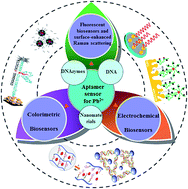Aptamer-based biosensors for detection of lead(ii) ion: a review
Abstract
Lead(II) ion (Pb2+) contamination can be accumulated along the food chain and cause a serious threat to public health. Plenty of research effort has thus been devoted to the development of fast, sensitive and selective biosensors for monitoring Pb2+. Aptamer especially Pb2+ based DNAzymes (obtained from a large DNA library via in vitro selection) and DNA molecules are highly selective for a number of metal ions. Therefore, aptamer-based biosensors have been extensively studied for Pb2+ ion detection with a high sensitivity. In this review, we explain the current progress of Pb2+ aptamer-based sensors mainly in three groups: fluorescent; colorimetric; and electrochemical biosensors.



 Please wait while we load your content...
Please wait while we load your content...